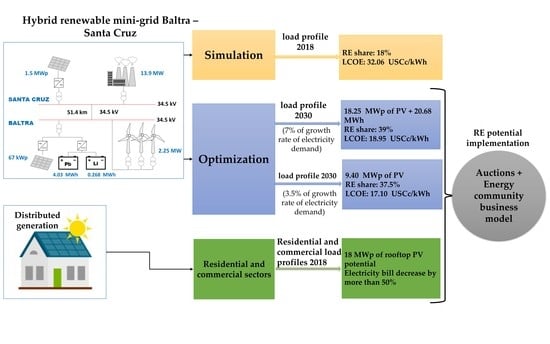Decarbonizing the Galapagos Islands: Techno-Economic Perspectives for the Hybrid Renewable Mini-Grid Baltra–Santa Cruz
Abstract
:1. Introduction
- What is the techno-economic RE potential to support the Agenda for Sustainable Development?
- To what extent can energy efficiency support the Agenda for Sustainable Development?
- Which business models are needed to support the implementation of new RE capacities and energy efficiency?
2. Galapagos Islands Framework
2.1. Energy Policies Status in the Galapagos Islands
2.2. The Electricity Generation Matrix of the Galapagos Islands
2.3. Hybrid Renewable Mini-Grid Baltra–Santa Cruz
3. Materials and Methods
3.1. Techno-Economic Information
3.1.1. Renewable Energy Resources
3.1.2. Load Data
3.1.3. Existing System
Photovoltaic and Battery Systems
Wind Turbine System
Gensets and Fuel Consumption
Biodiesel
Operating Reserve
3.1.4. Costs
3.2. Energy System Model
3.2.1. Net Present Cost (NPC)
3.2.2. Levelized Cost of Electricity (LCOE)
3.3. Description of Scenarios
3.3.1. Status quo Scenarios
3.3.2. Renewable Energy Potential Scenarios
Renewable Energy Potential: Boundary Conditions
3.3.3. Energy Efficiency Scenarios
Energy Efficiency: Boundary Conditions
3.3.4. Distributed Generation Scenario
4. Results and Discussion
4.1. Results of the Status quo Scenarios
4.2. Results of the Renewable Energy Potential Scenarios
4.2.1. Results of the Renewable Energy Potential: Boundary Conditions
4.2.2. Results of the Renewable Energy Potential: High RE Share
4.3. Results of the Energy Efficiency Scenarios
4.3.1. Results of the Energy Efficiency: Boundary Conditions
4.3.2. Results of the Energy Efficiency: High RE Share
4.4. Results of the Distributed Generation Scenario
4.5. Sensitivity Analysis
- (i)
- Table 11 shows the sensitivity results of the “Status quo 2018” Scenario to supply the current demand: 32 GWh (7.26 MW of peak demand).
- (ii)
- Table 12 shows the results of the sensitivity analysis of the “Renewable Energy Potential: Boundary Conditions Scenario, configuration: PV + wind + batteries + diesel” to cover 73.7 GWh of demand in 2030 (16.35 MW-peak demand).
- (iii)
- Again, Table 13 summarizes the sensitivity results of the “Energy Efficiency: Boundary Conditions Scenario, configuration: PV + wind + batteries + diesel” to supply 49.45 GWh (peak load: 10.97 MW) in 2030.
- (iv)
- Other applicable solutions are the “Distributed Generation” Scenarios in residential and commercial sectors and Table 14 shows the results of the sensitivity analyses.
5. Business Model Proposal for RE Introduction
- -
- The auction business model supports the widespread installation of RE power and provides the capacity required by the residential and commercial sectors for distributed generation. Here, the private sector is in charge of installing, operating and maintaining a large RE capacity. At the residential and commercial levels, the private sector ensures maintenance as an incentive for prosumers. The Power Purchase Agreement should collect all these aspects.The auctions concession period can be 20 years, including guarantees for renewal. Otherwise, when there is no private continuity over time, business models tend to be unsuccessful [8].
- -
- The residential and commercial sector creates cooperatives through a citizen energy community model based on a net-metering scheme for PV rooftop installations. The auction scheme ensures the maintenance of PV systems. Solar adopters can be homeowners, building owners or tenants. The people set up cooperatives to facilitate the acquisition and management of solar systems. This model also enables conditions which involve other actors/sectors within energy communities.
- -
- The Ministry of Energy (MERNNR) is the main promoter and is responsible for energy policies (RE and energy efficiency), management and funding.
- -
- The Agency for Regulation and Control of Electricity (ARCONEL) is responsible for the control of RE projects and for the design of technical and economic regulations that build an appropriate environment for business model application.
- -
- The Government Council for the Galapagos Special Regime (CGREG) works as a facilitator and supports energy policies implementation.
- -
- The local municipality designs strategies for enabling PV integration adapted for the beneficiary.
- -
- The Ministry of Environment (MAE) and the Galapagos National Park Directorate (PNG) fund the auction process through tourism contributions. Tourism taxes vary from $3 US for Ecuadorians to $100 US for international tourists [147]. Since this is the most important activity of the islands and relates to environmental impact, a tourism energy fee could be designed to support energy initiatives with the participation of the partners of this proposal.It is recognized that a comprehensive understanding of the dynamics of tourism is relevant in terms of management effectiveness and efficiency on small islands [148,149]. Here, ecotourism, which is conceived for biodiversity preservation by reducing the impact of mass tourism, also implies the adoption of RE technologies for guaranteeing a sustainable energy supply [150,151]. Ecotourism is widely supported by international cooperation and environmental organizations through incentives and funds, which helps to mobilize the tourism market [150]. Similarly, revenues derived from tourism taxes can also support money flow in ecotourism and the quality of the service [152]. Authors [153,154,155,156] have asserted that well-informed and environmentally aware tourists are willing to pay an additional fee for environmental conservation actions or to spend in a green hotel equipped with energy saving and RE installations. A previous study showed that, in the Galapagos Islands, visitors are willing to pay an additional fee of $50 USD per visit for a reduction in the carbon footprint [156]. This shows that sustainable actions in tourism-based environments, as in the case of the Galapagos, can generate direct benefits on the tourism sector, the local economy and environmental protection. Then, the national and local decision-making have the main responsibility to encourage RE investments in the tourism sector via effective policies and business proposals.
- -
- Electricity Corporation of Ecuador (CELEC EP) supports grid connection and the O&M of diesel power plants.
- -
- ELECGALAPAGOS supports management, PV residential grid connections, control and electricity fees collection and the O&M of previous RE projects installed.
- -
- International cooperation works on advising RE and energy efficiency policies and supporting awareness campaigns and capacity building at the institutional and community levels.
- -
- The private sector invests in large capacity projects and provides the PV capacity required by the residential and commercial sectors and other actors. Moreover, it is in charge of technical training and O&M.
- -
- Banking facilities provide credits to homeowners, building owners, tenants or other members of energy communities to acquire PV systems. In fact, there is a pioneer bank, ProCredit Bank Ecuador, that has implemented a credit line to support PV system acquisition [157].
- -
- Prosumers are responsible for the adequate management of their installations and changing traditional and inefficient ways of energy consumption.
6. Conclusions and Policy Implications
Author Contributions
Funding
Acknowledgments
Conflicts of Interest
Abbreviations
| ADS | Autonomous Desalination Systems |
| ARCONEL | Ecuadorian Agency for Regulation and Control of Electricity |
| BMU | German Federal Ministry for the Environment, Nature Conservation, Building and Nuclear Safety |
| CELEC EP | Electricity Corporation of Ecuador |
| CGREG | Government Council for the Galapagos Special Regime |
| CRF | Capital Recovery Factor |
| DG | Diesel gensets |
| ELECGALAPAGOS | Electricity Company Galapagos |
| EoI | Expressions of Interest |
| GDP | Gross Domestic Product |
| GEF | Global Environment Facility |
| GHG | Greenhouse gas |
| GHI | Global Horizontal solar Irradiation |
| GIZ | Germany International Cooperation Agency |
| GSEP | Global Sustainable Electricity Partnership |
| HOMER | Hybrid Optimization of Multiple Electric Renewables |
| IICA | Inter-American Institute for Cooperation on Agriculture |
| INDC | Intended Nationally Determined Contribution |
| JICA | Japan International Cooperation Agency |
| KOICA | Korea International Cooperation Agency |
| LCOE | Levelized Cost of Electricity |
| LOSPEE | Organic Law of Public Electricity Service |
| MAE | Ecuadorian Ministry of Environment |
| MERNNR | Ministry of Energy and Non-Renewable Natural Resources |
| MBOE | million barrels of oil equivalent |
| NEC | Ecuadorian Building Standard |
| NPC | Net Present Cost |
| NREL | National Renewable Energy Laboratory |
| oemof | Python-library Open Energy Modelling Framework |
| O&M | Operation and maintenance |
| PME | Ecuadorian Electricity Master Plan 2016–2025 |
| PNG | Galapagos National Park Directorate |
| PPA | Power Purchase Agreement |
| PV | Photovoltaic |
| RE | Renewable energy |
| SDG7 | Sustainable Development Goal number 7 |
| SNI | National Interconnected System |
| SOC | State of charge |
| UNDP | United Nation Development Program |
| UNESCO | United Nations Educational, Scientific and Cultural Organization |
| UNF | United Nations Foundation |
References
- Bertheau, P.; Blechinger, P. Resilient solar energy island supply to support SDG7 on the Philippines: Techno-economic optimized electrification strategy for small islands. Util. Policy 2018, 54, 55–77. [Google Scholar] [CrossRef]
- Cross, S.; Padfield, D.; Ant-Wuorinen, R.; King, P.; Syri, S. Benchmarking island power systems: Results, challenges, and solutions for long term sustainability. Renew. Sustain. Energy Rev. 2017, 80, 1269–1291. [Google Scholar] [CrossRef]
- Kuang, Y.; Zhang, Y.; Zhou, B.; Li, C.; Cao, Y.; Li, L.; Zeng, L. A review of renewable energy utilization in islands. Renew. Sustain. Energy Rev. 2016, 59, 504–513. [Google Scholar] [CrossRef]
- Al Katsaprakakis, D.; Voumvoulakis, M. A hybrid power plant towards 100% energy autonomy for the island of Sifnos, Greece. Perspectives created from energy cooperatives. Energy 2018, 161, 680–698. [Google Scholar] [CrossRef]
- Bertheau, P.; Cader, C. Electricity sector planning for the Philippine islands: Considering centralized and decentralized supply options. Appl. Energy 2019, 251, 113393. [Google Scholar] [CrossRef]
- Blechinger, P.; Cader, C.; Bertheau, P.; Huyskens, H.; Seguin, R.; Breyer, C. Global analysis of the techno-economic potential of renewable energy hybrid systems on small islands. Energy Policy 2016, 98, 674–687. [Google Scholar] [CrossRef]
- Praene, J.P.; Payet, M.; Bénard-Sora, F. Sustainable transition in small island developing states: Assessing the current situation. Util. Policy 2018, 54, 86–91. [Google Scholar] [CrossRef] [Green Version]
- Eras-Almeida, A.A.; Egido-Aguilera, M.A. Hybrid renewable mini-grids on non-interconnected small islands: Review of case studies. Renew. Sustain. Energy Rev. 2019, 116, 109417. [Google Scholar] [CrossRef]
- Red Eléctrica España. Electricity demand: Canary Islands. Available online: https://www.ree.es/es/series-estadisticas-por-comunidades-autonomas (accessed on 14 October 2019).
- Neves, D.; Silva, C.A.; Connors, S. Design and implementation of hybrid renewable energy systems on micro-communities: A review on case studies. Renew. Sustain. Energy Rev. 2014, 31, 935–946. [Google Scholar] [CrossRef]
- Weir, T. Renewable energy in the Pacific Islands: Its role and status. Renew. Sustain. Energy Rev. 2018, 94, 762–771. [Google Scholar] [CrossRef]
- Delille, G.; François, B.; Malarange, G. Dynamic frequency control support by energy storage to reduce the impact of wind and solar generation on isolated power system’s inertia. IEEE Trans. Sustain. Energy 2012, 3, 931–939. [Google Scholar] [CrossRef]
- Sarasúa, J.I.; Martínez-Lucas, G.; Lafoz, M. Analysis of alternative frequency control schemes for increasing renewable energy penetration in El Hierro Island power system. Int. J. Electr. Power Energy Syst. 2019, 113, 807–823. [Google Scholar] [CrossRef]
- Selosse, S.; Garabedian, S.; Ricci, O.; Maïzi, N. The renewable energy revolution of Reunion island. Renew. Sustain. Energy Rev. 2018, 89, 99–105. [Google Scholar] [CrossRef] [Green Version]
- Electricity Company Elecgalapagos. Electricity Balance. 2018; (unpublished, institutional information). [Google Scholar]
- Electricity Company Elecgalapagos. Montly and Annual Electricity Demand. 2018; (unpublished, institutional information). [Google Scholar]
- Agency for Regulation and Control of Electricity (ARCONEL). Cost of Electricity Service—Galapagos. 2019; (unpublished, institutional information). [Google Scholar]
- Marchán, E.; Espinasa, R.; Yépez-García, A. The Other Side of the Boom. Energy Prices and Subsidies in Latin America and the Caribbean During the Super-Cycle; Inter-American Development Bank (IDB): Washington, DC, USA, 2017; Available online: https://publications.iadb.org/en/other-side-boom-energy-prices-and-subsidies-latin-america-and-caribbean-during-super-cycle (accessed on 20 October 2019).
- Dennis, A. Household welfare implications of fossil fuel subsidy reforms in developing countries. Energy Policy 2016, 96, 597–606. [Google Scholar] [CrossRef]
- Ponce-Jara, M.A.; Castro, M.; Pelaez-Samaniego, M.R.; Espinoza-Abad, J.L.; Ruiz, E. Electricity sector in Ecuador: An overview of the 2007–2017 decade. Energy Policy 2018, 113, 513–522. [Google Scholar] [CrossRef]
- Bhattacharyya, S.C.; Palit, D. Mini-grid based off-grid electrification to enhance electricity access in developing countries: What policies may be required? Energy Policy 2016, 94, 166–178. [Google Scholar] [CrossRef] [Green Version]
- Chavez-Rodriguez, M.F.; Carvajal, P.E.; Martinez Jaramillo, J.E.; Egüez, A.; Mahecha, R.E.G.; Schaeffer, R.; Szklo, A.; Lucena, A.F.P.; Arango Aramburo, S. Fuel saving strategies in the Andes: Long-term impacts for Peru, Colombia and Ecuador. Energy Strateg. Rev. 2018, 20, 35–48. [Google Scholar] [CrossRef]
- Sinha, S.; Chandel, S.S. Review of software tools for hybrid renewable energy systems. Renew. Sustain. Energy Rev. 2014, 32, 192–205. [Google Scholar] [CrossRef]
- Erdinc, O.; Uzunoglu, M. Optimum design of hybrid renewable energy systems: Overview of different approaches. Renew. Sustain. Energy Rev. 2012, 16, 1412–1425. [Google Scholar] [CrossRef]
- Bahramara, S.; Moghaddam, M.P.; Haghifam, M.R. Optimal planning of hybrid renewable energy systems using HOMER: A review. Renew. Sustain. Energy Rev. 2016, 62, 609–620. [Google Scholar] [CrossRef]
- Government Council for the Galapagos Special Regime (CGREG). Galapagos Plan 2015-2020. Plan for Sustainable Development and Territorial Ordering for the Galapagos Special Regime; CGREG: Puerto Ayora, Ecuador, 2015; Available online: https://es.slideshare.net/radioencantada/plan-galpagos-2015-2020 (accessed on 20 October 2019).
- Ministry of the Environment of Ecuador. Galapagos National Park. Available online: http://areasprotegidas.ambiente.gob.ec/es/todas-areas-protegidas-por-region?t=G (accessed on 19 November 2019).
- Galapagos National Park Directorate. The Management Plan for the Protected Areas of Galapagos for Good Living; Galapagos National Park, Ministry of Environment: Puerto Ayora, Ecuador, 2014; Available online: http://www.galapagos.gob.ec/wp-content/uploads/downloads/2016/07/DPNG_Plan_de_Manejo_2014.pdf (accessed on 19 November 2019).
- Government Council for the Galapagos Special Regime (CGREG). Integrated Indicador System of Galapagos. Available online: https://siicg.gobiernogalapagos.gob.ec/ (accessed on 27 August 2019).
- Galapagos National Park Directorate. Tourism Statistics. Available online: http://www.galapagos.gob.ec/estadistica-de-visitantes/ (accessed on 27 August 2019).
- Pizzitutti, F.; Walsh, S.J.; Rindfuss, R.R.; Gunter, R.; Quiroga, D.; Tippett, R.; Mena, C.F. Scenario planning for tourism management: A participatory and system dynamics model applied to the Galapagos Islands of Ecuador. J. Sustain. Tour. 2017, 25, 1117–1137. [Google Scholar] [CrossRef]
- Claudino-Sales, V. Galápagos Islands, Ecuador. In Coastal World Heritage Sites; Springer Netherlands: Dordrecht, The Netherlands, 2019; pp. 327–333. ISBN 978-94-024-1528-5. [Google Scholar]
- Walsh, S.J.; Mena, C.F. Interactions of social, terrestrial, and marine sub-systems in the Galapagos Islands, Ecuador. Proc. Natl. Acad. Sci. USA 2016, 113, 14536LP–14543LP. [Google Scholar] [CrossRef] [PubMed] [Green Version]
- González, J.A.; Montes, C.; Rodriguez, J.; Tapia, W. Rethinking the Galapagos Islands as a complex social-ecological system: Implications for conservation and management. Ecol. Soc. 2008, 13. [Google Scholar] [CrossRef]
- Taylor, J.E.; Hardner, J.; Stewart, M. Ecotourism and economic growth in the Galapagos: An island economy-wide analysis. Environ. Dev. Econ. 2009, 14, 139–162. [Google Scholar] [CrossRef] [Green Version]
- Central Bank of Ecuador. Gross Value Added 2007—2016. Available online: https://sintesis.bce.fin.ec/BOE/OpenDocument/1602171408/OpenDocument/opendoc/openDocument.faces?logonSuccessful=true&shareId=3 (accessed on 16 October 2019).
- Ecuadorian National Institute of Statistics and Census (INEC). Population Projections. Available online: https://www.ecuadorencifras.gob.ec/proyecciones-poblacionales/ (accessed on 27 August 2019).
- Agency for Regulation and Control of Electricity (ARCONEL). Annual Electricity Consumption Per Capita. Available online: https://www.regulacionelectrica.gob.ec/recaudacion-anual/ (accessed on 8 February 2020).
- United Nations Development Programme (UNDP). Green Energy for Galapagos, Inexhaustible, Clean and Safe; UNDP: Quito, Ecuador, 2016; Available online: https://www.undp.org/content/dam/ecuador/docs/documentos%20proyectos%20ambiente/pnud_ec%20REVISTA%20ENERGIA%20VERDE%20PARA%20GALAPAGOS-ilovepdf-compressed.pdf (accessed on 15 July 2019).
- Eras-Almeida, A.A.; Egido-Aguilera, M.A. Quality control applied to the photovoltaic systems of the Galapagos Islands: The case of Baltra and Santa Cruz. In Proceedings of the 3rd International Hybrid Power Systems Workshop; Energynautics GmbH, Tenerife, Spain, 8–9 May 2018. [Google Scholar]
- Ecuadorian Electrical Sector Regime Law (LRSE). Official Register No. 43; National Congress of Ecuador: Quito, Ecuador, 2011. [Google Scholar]
- Ecuadorian Organic Law of Public Electricity Service (LOSPEE). Official Register No. 418; National Assembly of Ecuador: Quito, Ecuador, 2015. [Google Scholar]
- Ecuadorian General Regulation of the Organic Law of Public Electricity Service (LOSPEE). Official Register No. 855; Presidency of the Republic of Ecuador: Quito, Ecuador, 2019. [Google Scholar]
- Ministry of Electricity and Renewable Energy. Ecuadorian Electricity Master Plan 2016–2025. 2017. Available online: https://www.regulacionelectrica.gob.ec/plan-maestro-de-electrificacion/ (accessed on 15 August 2019).
- Technical Secretariat Plans Ecuador National Plan of Development 2017–2021. 2017. Available online: https://www.planificacion.gob.ec/wp-content/uploads/downloads/2017/10/PNBV-26-OCT-FINAL_0K.compressed1.pdf (accessed on 17 September 2019).
- Ecuadorian Organic Code of Production, Trade and Investment; Second Supplement of the Official Registry No. 056, 12-VIII-2013; National Assembly of Ecuador: Quito, Ecuador, 2015.
- Agency for Regulation and Control of Electricity (ARCONEL). Photovoltaic Microgeneration to Electricity Self-Sufficiency for Final Consumers of Electricity, Regulation ARCONEL No. 003/18. Available online: https://www.regulacionelectrica.gob.ec/wp-content/uploads/downloads/2019/01/Codificacion-Regulacion-No.-ARCONEL-003-18.pdf (accessed on 3 July 2019).
- Agency for Regulation and Control of Electricity (ARCONEL). Resolution No. ARCONEL 057/18 of the Regulation No. ARCONEL 003-18. Available online: https://www.regulacionelectrica.gob.ec/wp-content/uploads/downloads/2019/01/Reforma-a-la-Regulacion-Microgeneracion.pdf (accessed on 3 July 2019).
- Agency for Regulation and Control of Electricity (ARCONEL). Rate Schedule for Electricity Companies. Period: January–December 2019; ARCONEL: Quito, Ecuador, 2019. [Google Scholar]
- Llerena-Pizarro, O.R.; Micena, R.P.; Tuna, C.E.; Silveira, J.L. Electricity sector in the Galapagos Islands: Current status, renewable sources, and hybrid power generation system proposal. Renew. Sustain. Energy Rev. 2019, 108, 65–75. [Google Scholar] [CrossRef]
- Inter-American Development Bank (IADB); Ministry of Electricity and Renewable Energy (MEER). National Plan for Energy Efficiency; IADB; MEER: Quito, Ecuador, 2017; Available online: https://www.cnelep.gob.ec/plan-nacional-eficiencia-energetica/ (accessed on 7 August 2019).
- Ecuadorian Organic Law of Energy Efficiency, Official Register No. 449; National Assembly of Ecuador: Quito, Ecuador, 2019.
- Ministry of the Environment. First Intended Nationally Determined Contribution of Ecuador to the Paris Agreement Under the United Nations Framework on Climate Change. 2019. Available online: https://www4.unfccc.int/sites/ndcstaging/PublishedDocuments/Ecuador%20First/Primera%20NDC%20Ecuador.pdf (accessed on 11 August 2019).
- Ministry of the Environment. Third National Comunication of Ecuador to the United Nations Climate Change Convention. 2017. Available online: https://www.ambiente.gob.ec/wp-content/uploads/downloads/2017/10/TERCERA-COMUNICACION-BAJA-septiembre-20171-ilovepdf-compressed1.pdf (accessed on 11 August 2019).
- Michalena, E.; Kouloumpis, V.; Hills, J.M. Challenges for Pacific Small Island Developing States in achieving their Nationally Determined Contributions (NDC). Energy Policy 2018, 114, 508–518. [Google Scholar] [CrossRef]
- Michalena, E.; Hills, J.M. Paths of renewable energy development in small island developing states of the South Pacific. Renew. Sustain. Energy Rev. 2018, 82, 343–352. [Google Scholar] [CrossRef]
- Contract for Operation, Maintenance and Management of the Generation Power Plants of ELECGALAPAGOS. Contract No. 0000156; Elecgalapagos, Celec EP: Quito, Ecuador, 2012; (unpublished, institutional information).
- Agency for Regulation and Control of Electricity (ARCONEL). Study of Operating Deficit of Elecgalapagos. 2016; (unpublished, institutional information). [Google Scholar]
- Ecuadorian National Center of Electricity Electricity (CENACE). Electricity Production (MWh). Available online: http://www.cenace.org.ec/docs/InformacionOperativa.htm (accessed on 22 November 2019).
- Electricity Company ELECGALAPAGOS. Power Generation Capacity. 2018; (unpublished, institutional information). [Google Scholar]
- Betzold, C. Fuelling the Pacific: Aid for renewable energy across Pacific Island countries. Renew. Sustain. Energy Rev. 2016, 58, 311–318. [Google Scholar] [CrossRef]
- DIGSILENT, Ecuadorian National Center of Electricity Electricity (CENACE). Study of the Electrical Operation of the Hybrid Power System of the Galapagos Islands. 2013; (unpublished, institutional information). [Google Scholar]
- Hitachi. Lead Acid Batteries VRLA to Stabilize Electric Photovoltaic and Wind Power Systems. Available online: https://www.jase-w.eccj.or.jp/technologies-s/pdf/electricity/E-05.pdf (accessed on 12 June 2019).
- Terada, M.; Takabayashi, H. Industrial storage device for low-carbon society. Hitachi Rev. 2011, 60, 22–27. Available online: http://www.hitachi.com/rev/pdf/2011/r2011_01_104.pdf (accessed on 12 June 2019).
- Electricity Company ELECGALAPAGOS. Statistics: Electricity demand of Baltra and Santa Cruz. 2018; (unpublished, institutional information). [Google Scholar]
- HOMER Pro 3.13. Available online: https://www.homerenergy.com/products/pro/docs/latest/index.html (accessed on 26 October 2019).
- Padrón, I.; Avila, D.; Marichal, G.N.; Rodríguez, J.A. Assessment of Hybrid Renewable Energy Systems to supplied energy to Autonomous Desalination Systems in two islands of the Canary Archipelago. Renew. Sustain. Energy Rev. 2019, 101, 221–230. [Google Scholar] [CrossRef]
- Demiroren, A.; Yilmaz, U. Analysis of change in electric energy cost with using renewable energy sources in Gökceada, Turkey: An island example. Renew. Sustain. Energy Rev. 2010, 14, 323–333. [Google Scholar] [CrossRef]
- Kalinci, Y. Alternative energy scenarios for Bozcaada island, Turkey. Renew. Sustain. Energy Rev. 2015, 45, 468–480. [Google Scholar] [CrossRef]
- Ali, I.; Shafiullah, G.M.; Urmee, T. A preliminary feasibility of roof-mounted solar PV systems in the Maldives. Renew. Sustain. Energy Rev. 2018, 83, 18–32. [Google Scholar] [CrossRef]
- Clairand, J.M.; Arriaga, M.; Canizares, C.A.; Alvarez, C. Power Generation Planning of Galapagos’ Microgrid Considering Electric Vehicles and Induction Stoves. IEEE Trans. Sustain. Energy 2018, 10, 1916–1926. [Google Scholar] [CrossRef]
- Rosso-Cerón, A.M.; Kafarov, V.; Latorre-Bayona, G.; Quijano-Hurtado, R. A novel hybrid approach based on fuzzy multi-criteria decision-making tools for assessing sustainable alternatives of power generation in San Andrés Island. Renew. Sustain. Energy Rev. 2019, 110, 159–173. [Google Scholar] [CrossRef]
- Mahesh, A.; Sandhu, K.S. Hybrid wind/photovoltaic energy system developments: Critical review and findings. Renew. Sustain. Energy Rev. 2015, 52, 1135–1147. [Google Scholar] [CrossRef]
- Cevallos-Sierra, J.; Ramos-Martin, J. Spatial assessment of the potential of renewable energy: The case of Ecuador. Renew. Sustain. Energy Rev. 2018, 81, 1154–1165. [Google Scholar] [CrossRef]
- Electricity Company ELECGALAPAGOS. Statistics: Global Horizontal Solar Irradiation. 2017; (unpublished, institutional information). [Google Scholar]
- Electricity Company ELECGALAPAGOS. Statistics: Wind Speed. 2018; (unpublished, institutional information). [Google Scholar]
- Electricity Company ELECGALAPAGOS. Sectorial Electricity Consumption. 2018; (unpublished, institutional information). [Google Scholar]
- Electricity Company ELECGALAPAGOS. Residential Load Profile. 2018; (unpublished, institutional information). [Google Scholar]
- Electricity Company ELECGALAPAGOS. Commercial Load Profile. 2018; (unpublished, institutional information). [Google Scholar]
- Electricity Company ELECGALAPAGOS. Baltra: Statisticts of the Battery Storage Systems. 2018; (unpublished, institutional information). [Google Scholar]
- Electricity Company ELECGALAPAGOS. Plan of Maintenance of the Generation Power Systems of Baltra and Santa Cruz. 2018; (unpublished, institutional information). [Google Scholar]
- Windtest Kaiser-Wilhelm-Koog Certification Report: Power Performance Measurement on a UNISON US7 750 kW Wind Turbine. 2007; (unpublished, institutional information).
- Electricity Company ELECGALAPAGOS. Diesel Consumption and Costs. 2018; (unpublished, institutional information). [Google Scholar]
- Hyundai. Diesel Generators Datasheet, 2012; (unpublished, information provided by ELECGALAPAGOS).
- Caterpilar. Diesel Generators Datasheet, 2008; (unpublished, information provided by ELECGALAPAGOS).
- PETROECUADOR, EP. Fuel Prices. 2019. Available online: https://www.eppetroecuador.ec/wp-content/uploads/downloads/2019/03/PRECIOS-MARZO-2019-MENSUAL-SNI-DEL-07-AL-13-DE-MARZO-2019.pdf (accessed on 10 April 2019).
- US Energy Information Administration. Diesel Spot Price (Dollars Per Gallon). Available online: https://www.eia.gov/dnav/pet/hist/LeafHandler.ashx?n=pet&s=eer_epd2dxl0_pf4_y35ny_dpg&f=a (accessed on 28 October 2019).
- Electricity Company ELECGALAPAGOS. Import Fees—Fuel. 2019; (unpublished, institutional information). [Google Scholar]
- Inter-American Institute for Cooperation on Agriculture (ICCA). “ARE Award 2017”. Award for the Jartropha Project of Manabi for Galapagos. Available online: http://www.iica.int/es/prensa/noticias/premio-“are-award-2017”-para-el-proyecto-piñón-de-manabí-para-galápagos (accessed on 20 June 2019).
- Ministry of Electricity and Renewable Energy (MEER). Project: K015 MEER—Production of Jatropha oil for the Pilot Project of Electricity Generation of Galapagos; MEER: Quito, Ecuador, 2017. [Google Scholar]
- Inter-American Institute for Cooperation on Agriculture (IICA). Jatropha and Biodiesel Production Report. 2017; (unpublished, institutional information). [Google Scholar]
- Cooperative of Producers of Jathropa (COOPROCERMA). Jatropha oil Prices—Galapagos. 2019; (unpublished, institutional information). [Google Scholar]
- National Electricity Board (CONELEC). Standard 006/00: Dispatch and Operation Procedure 2000. Available online: https://www.regulacionelectrica.gob.ec/wp-content/uploads/downloads/2015/10/ProcedimientosDespacho.pdf (accessed on 10 April 2019).
- Electricity Corporation of Ecuador (CELEC EP). Dinamic Stability Study of the Power System of Baltra and Santa Cruz, Galapagos. 2018; (unpublished, institutional information). [Google Scholar]
- Reiners, N.; Bopp, G.; Wüllner, J.; Gobinda Yadav, R. Optimal Integration of Photovoltaics in Micro—Grids that are Dominated by Diesel Power Plants; International Energy Agency’s Photovoltaic Power Systems Program (IEA PVSP); Fraunhofer-Institute for Solar Energy Systems (ISE): Freiburg, Germany, 2019; Available online: http://www.iea-pvps.org/fileadmin/dam/intranet/task9/IEA-PVPS_T09-19-2019-REPORT_Integration_of_PV_in_Diesel_Micro-grids.pdf (accessed on 12 August 2019).
- Watson, D.; Rodgers, M. Utility-scale storage providing peak power to displace on-island diesel generation. J. Energy Storage 2019, 22, 80–87. [Google Scholar] [CrossRef]
- Palizban, O.; Kauhaniemi, K. Energy storage systems in modern grids—Matrix of technologies and applications. J. Energy Storage 2016, 6, 248–259. [Google Scholar] [CrossRef]
- Palizban, O.; Kauhaniemi, K. Microgrid control principles in island mode operation. In Proceedings of the 2013 IEEE Grenoble Conf. PowerTech, Grenoble, France, 16–20 June 2013; pp. 1–6. [Google Scholar] [CrossRef]
- Guerrero, J.M.; Hang, L.; Uceda, J. Control of Distributed Uninterruptible Power Supply Systems. IEEE Trans. Ind. Electron. 2008, 55, 2845–2859. [Google Scholar] [CrossRef] [Green Version]
- International Renewable Energy Agency (IRENA). Transforming Small-Islands Power Systems: Technical Planning Studies for the Integration of Variable Renewables; IRENA: Abu Dhabi, UAE, 2018. [Google Scholar]
- Electricity Company ELECGALAPAGOS. Renewable Energy Technologies Inventory. 2018; (unpublished, institutional information). [Google Scholar]
- International Renewable Energy Agency (IRENA). Renewable Power Generation Costs in 2018; IRENA: Abu Dhabi, UAE, 2019. [Google Scholar]
- International Renewable Energy Agency (IRENA). Electricity Storage and Renewables: Costs and Markets to 2030; IRENA: Abu Dhabi, UAE, 2017. [Google Scholar]
- García, L.; Parikh, M.; Manghani, R. Future Evolution of Renewable Energy and Storage Costs in Latin America; Inter-American Development Bank (IDB): Washington, DC, USA, 2019; Available online: https://publications.iadb.org/publications/spanish/document/Evoluci%C3%B3n_futura_de_costos_de_las_energ%C3%ADas_renovables_y_almacenamiento_en_Am%C3%A9rica_Latina_es.pdf (accessed on 15 January 2020).
- Electricity Company ELECGALAPAGOS. Operation and Maintenance Costs of Generation Power Systems of Galapagos. 2018; (unpublished, institutional information). [Google Scholar]
- Solano, J.C.; Brito, M.C.; Caamaño-Martín, E. Impact of fixed charges on the viability of self-consumption photovoltaics. Energy Policy 2018, 122, 322–331. [Google Scholar] [CrossRef]
- Tecnical Secretariat Planning Ecuador. Public Investment Information. Available online: http://www.planificacion.gob.ec/informacion-de-inversion-publica/ (accessed on 29 October 2019).
- Central Bank of Ecuador (BCE). Inflation Report. Available online: https://www.bce.fin.ec/index.php/component/k2/item/317-informe-de-inflación (accessed on 29 October 2019).
- Shaahid, S.M.; El-Amin, I. Techno-economic evaluation of off-grid hybrid photovoltaic–diesel–battery power systems for rural electrification in Saudi Arabia—A way forward for sustainable development. Renew. Sustain. Energy Rev. 2009, 13, 625–633. [Google Scholar] [CrossRef]
- Margaret Amutha, W.; Rajini, V. Techno-economic evaluation of various hybrid power systems for rural telecom. Renew. Sustain. Energy Rev. 2015, 43, 553–561. [Google Scholar] [CrossRef]
- Tomar, V.; Tiwari, G.N. Techno-economic evaluation of grid connected PV system for households with feed in tariff and time of day tariff regulation in New Delhi—A sustainable approach. Renew. Sustain. Energy Rev. 2017, 70, 822–835. [Google Scholar] [CrossRef]
- Givler, T.; Lilienthal, P. Using HOMER Software, NREL’s Micropower Optimization Model, to Explore the Role of Gen-sets in Small Solar Power Systems Case Study: Sri Lanka; National Institute of Statistics and Census: Golden, CO, USA, 2005. Available online: https://www.nrel.gov/docs/fy05osti/36774.pdf (accessed on 19 March 2019).
- Masson, G.; Kaizuka, I. Trends 2018 in Photovoltaic Applications; International Energy Agency (IEA): Paris, France, 2018; Available online: http://www.iea-pvps.org/fileadmin/dam/intranet/task1/IEA_PVPS_Trends_2018_in_Photovoltaic_Applications.pdf (accessed on 15 April 2019).
- O’Shaughnessy, E.; Nemet, G.F.; Pless, J.; Margolis, R. Addressing the soft cost challenge in U.S. small-scale solar PV system pricing. Energy Policy 2019, 134, 110956. [Google Scholar] [CrossRef]
- Caamaño-Martín, E.; Egido, M.A.; Solórzano, J. Small-Scale PV Applications in Home and Business. In Solar Energy; Crawley, G.M., Ed.; World Scientific Series in Current Energy Issues; Marcus Enterprise LLC, University of South Carolina: Columbia, SA, USA, 2016; Volume 2, pp. 243–298. ISBN 978-981-4689-51-9. [Google Scholar]
- Kennedy, J. Permanently Unfinished: The Evolution of Architecture in the Galapagos Islands. Available online: https://www.archdaily.com/802383/permanently-unfinished-the-evolution-of-architecture-in-the-galapagos-islands (accessed on 29 January 2020).
- Ecuadorian National Institute of Statistics and Census (INEC). Galapagos Population and Housing Census. Available online: https://www.ecuadorencifras.gob.ec/censo-de-poblacion-y-vivienda-galapagos/ (accessed on 29 January 2020).
- Carvajal, P.E.; Li, F.G.N.; Soria, R.; Cronin, J.; Anandarajah, G.; Mulugetta, Y. Large hydropower, decarbonisation and climate change uncertainty: Modelling power sector pathways for Ecuador. Energy Strateg. Rev. 2019, 23, 86–99. [Google Scholar] [CrossRef]
- Mayorga, M.A.M. Sustainability Analysis of the Cycle Life of Electricity Based on Jatropa, a Case Study of Ecuador; Technical University of Madrid: Madrid, Spain, 2017. [Google Scholar]
- Mayorga, M.A.M.; Martínez, E.I.; Gómez, N.C. Jatropha suppliers as contributors to the sustainability of the production of bioelectricity in Ecuador. Sustainability 2017, 9, 1946. [Google Scholar] [CrossRef] [Green Version]
- Silalertruksa, T.; Bonnet, S.; Gheewala, S.H. Life cycle costing and externalities of palm oil biodiesel in Thailand. J. Clean. Prod. 2012, 28, 225–232. [Google Scholar] [CrossRef]
- Xu, Y.J.; Li, G.X.; Sun, Z.Y. Development of biodiesel industry in China: Upon the terms of production and consumption. Renew. Sustain. Energy Rev. 2016, 54, 318–330. [Google Scholar] [CrossRef]
- Liu, H.; Huang, Y.; Yuan, H.; Yin, X.; Wu, C. Life cycle assessment of biofuels in China: Status and challenges. Renew. Sustain. Energy Rev. 2018, 97, 301–322. [Google Scholar] [CrossRef]
- Holma, A.; Leskinen, P.; Myllyviita, T.; Manninen, K.; Sokka, L.; Sinkko, T.; Pasanen, K. Environmental impacts and risks of the national renewable energy targets—A review and a qualitative case study from Finland. Renew. Sustain. Energy Rev. 2018, 82, 1433–1441. [Google Scholar] [CrossRef]
- Schelly, C. Residential solar electricity adoption: What motivates, and what matters? A case study of early adopters. Energy Res. Soc. Sci. 2014, 2, 183–191. [Google Scholar] [CrossRef]
- Rai, V.; Reeves, D.C.; Margolis, R. Overcoming barriers and uncertainties in the adoption of residential solar PV. Renew. Energy 2016, 89, 498–505. [Google Scholar] [CrossRef]
- Caamaño, E.; Díaz-Palacios, S. Photovoltaic Solar Potential on Building Roofs of the City of Vitoria-Gasteiz: Characterization and Analysis; Solar Energy Institute- Technical University of Madrid (IES-UPM), Center of Environmental Studies (CEA), Municipality of Vitoria-Gasteiz: Madrid, Spain, 2019. [Google Scholar]
- U.S. Energy Information Administration (EIA). Annual Energy Outlook 2019 with Projections to 2050; U.S. Department of Energy: Washington, DC, USA, 2019; Volume 44.
- Horváth, D.; Szabó, R.Z. Evolution of photovoltaic business models: Overcoming the main barriers of distributed energy deployment. Renew. Sustain. Energy Rev. 2018, 90, 623–635. [Google Scholar] [CrossRef]
- Ruggiero, S.; Varho, V.; Rikkonen, P. Transition to distributed energy generation in Finland: Prospects and barriers. Energy Policy 2015, 86, 433–443. [Google Scholar] [CrossRef]
- Hoffmann, M.M.; Ansari, D. Simulating the potential of swarm grids for pre-electrified communities—A case study from Yemen. Renew. Sustain. Energy Rev. 2019, 108, 289–302. [Google Scholar] [CrossRef] [Green Version]
- Hoffmann, M.M.; Pelz, S.; Monés-pederzini, Ò.; Andreottola, M.; Blechinger, P. Overcoming the Bottleneck of Unreliable Grids: Increasing Reliability of Household Supply with Decentralized Backup Systems. J. Sustain. Res. 2020, 2. [Google Scholar] [CrossRef]
- Berendes, S.; Bertheau, P.; Blechinger, P. Sizing and Optimization of Hybrid Mini-Grids with micrOgridS-an Open-Source Modelling Tool. In Proceedings of the 3rd International Hybrid Power Systems Workshop; Energynautics GmbH, Tenerife, Spain, 8–9 May 2018. [Google Scholar]
- Morales, D.X.; Besanger, Y.; Sami, S.; Bel, C.A. Assessment of the impact of intelligent DSM methods in the Galapagos Islands toward a Smart Grid. Electr. Power Syst. Res. 2017, 146, 308–320. [Google Scholar] [CrossRef]
- Von Wirth, T.; Gislason, L.; Seidl, R. Distributed energy systems on a neighborhood scale: Reviewing drivers of and barriers to social acceptance. Renew. Sustain. Energy Rev. 2018, 82, 2618–2628. [Google Scholar] [CrossRef]
- Wüstenhagen, R.; Wolsink, M.; Bürer, M.J. Social acceptance of renewable energy innovation: An introduction to the concept. Energy Policy 2007, 35, 2683–2691. [Google Scholar] [CrossRef] [Green Version]
- Diesendorf, M.; Elliston, B. The feasibility of 100% renewable electricity systems: A response to critics. Renew. Sustain. Energy Rev. 2018, 93, 318–330. [Google Scholar] [CrossRef]
- Río, P. Energy for Sustainable Development Designing auctions for renewable electricity support. Best practices from around the world. Energy Sustain. Dev. 2017, 41, 1–13. [Google Scholar] [CrossRef]
- Dobrotkova, Z.; Surana, K.; Audinet, P. The price of solar energy: Comparing competitive auctions for utility-scale solar PV in developing countries. Energy Policy 2018, 118, 133–148. [Google Scholar] [CrossRef]
- Emiliano, B. 22 Bidders for Renewable Auctions in Ecuador. Available online: https://www.pv-magazine-latam.com/2019/10/31/22-postores-para-la-subasta-de-renovables-de-ecuador/ (accessed on 5 December 2019).
- Ecuadorian Ministry of Energy and Non-Renewable Natural Resources (MERNNR). Nine Companies Qualified for the Development of the El Aromo and Eólica Villonaco II and III Photovoltaic Projects. Available online: https://www.recursosyenergia.gob.ec/nueve-empresas-se-calificaron-para-el-desarrollo-de-los-proyectos-fotovoltaico-el-aromo-y-eolico-villonaco-ii-y-iii/ (accessed on 5 December 2019).
- INFOENERGETICA ECUADOR. Investment of $55 Million US in Renewable Energy Projects in Galapagos. Available online: https://www.infoenergetica.com/actualidad (accessed on 5 December 2019).
- Tongsopit, S.; Moungchareon, S.; Aksornkij, A.; Potisat, T. Business models and financing options for a rapid scale-up of rooftop solar power systems in Thailand. Energy Policy 2016, 95, 447–457. [Google Scholar] [CrossRef] [Green Version]
- Thakur, J.; Chakraborty, B. Impact of compensation mechanisms for PV generation on residential consumers and shared net metering model for developing nations: A case study of India. J. Clean. Prod. 2019, 218, 696–707. [Google Scholar] [CrossRef]
- Sperling, K. How does a pioneer community energy project succeed in practice? The case of the Samsø Renewable Energy Island. Renew. Sustain. Energy Rev. 2017, 71, 884–897. [Google Scholar] [CrossRef]
- Tounquet, F.; De Vos, L.; Abada, I.; Kielichowska, I.; Lessmann, C. Energy Communities in the European Union; Advanced System Studies for Energy Transition (ASSET), European Commission: Brussels, Belgium, 2019; Available online: https://asset-ec.eu/wp-content/uploads/2019/07/ASSET-Energy-Comminities-Revised-final-report.pdf (accessed on 5 December 2019).
- Galapagos National Park Directorate. Tourism Taxes. Available online: http://www.galapagos.gob.ec/tributo-de-ingreso/ (accessed on 11 December 2019).
- Kurniawan, F.; Adrianto, L.; Bengen, D.G.; Prasetyo, L.B. Vulnerability assessment of small islands to tourism: The case of the Marine Tourism Park of the Gili Matra Islands, Indonesia. Glob. Ecol. Conserv. 2016, 6, 308–326. [Google Scholar] [CrossRef] [Green Version]
- Nesticò, A.; Maselli, G. Sustainability indicators for the economic evaluation of tourism investments on islands. J. Clean. Prod. 2020, 248. [Google Scholar] [CrossRef]
- Egido-Aguilera, M.Á.; Solórzano, J.; Fernández, M. Towards Energy Sustainability in Ecolodges for Latin America: A case in the Bolivian Amazon. In Proceedings of the 7th International Conference on PV-Hybrid and Mini-Grid, Bad Hersfeld, Germany, 10–11 April 2014; pp. 1–6. [Google Scholar]
- Michalena, E.; Hills, J.; Amat, J.P. Developing sustainable tourism, using a multicriteria analysis on renewable energy in Mediterranean Islands. Energy Sustain. Dev. 2009, 13, 129–136. [Google Scholar] [CrossRef]
- Soomauroo, Z.; Blechinger, P.; Creutzig, F. Unique Opportunities of Island States to Transition to a Low—Carbon Mobility System. Sustainability 2020, 12, 1435. [Google Scholar] [CrossRef] [Green Version]
- Kostakis, I.; Sardianou, E. Which factors affect the willingness of tourists to pay for renewable energy? Renew. Energy 2012, 38, 169–172. [Google Scholar] [CrossRef]
- Schuhmann, P.W.; Skeete, R.; Waite, R.; Lorde, T.; Bangwayo-Skeete, P.; Oxenford, H.A.; Gill, D.; Moore, W.; Spencer, F. Visitors’ willingness to pay marine conservation fees in Barbados. Tour. Manag. 2019, 71, 315–326. [Google Scholar] [CrossRef]
- Tsagarakis, K.P.; Bounialetou, F.; Gillas, K.; Profylienou, M.; Pollaki, A.; Zografakis, N. Tourists’ attitudes for selecting accommodation with investments in renewable energy and energy saving systems. Renew. Sustain. Energy Rev. 2011, 15, 1335–1342. [Google Scholar] [CrossRef]
- Powell, R.B.; Ham, S.H. Can ecotourism interpretation really lead to pro-conservation knowledge, attitudes and behaviour? Evidence from the Galapagos Islands. J. Sustain. Tour. 2008, 16, 467–489. [Google Scholar] [CrossRef]
- El Mercurio. ProCredit Bank Sings an Agreement with the Solar Panles Company J3M Global S.A. Available online: https://ww2.elmercurio.com.ec/2019/10/24/banco-procredit-firma-acuerdo-con-la-empresa-de-paneles-solares-j3m-global-s-a/?fbclid=IwAR3oUN5XCYERwaOIp4dq1oNNoNuwo7qF6z2Ys35UDFFkyDRl1d7bDNrZqTo (accessed on 11 December 2019).



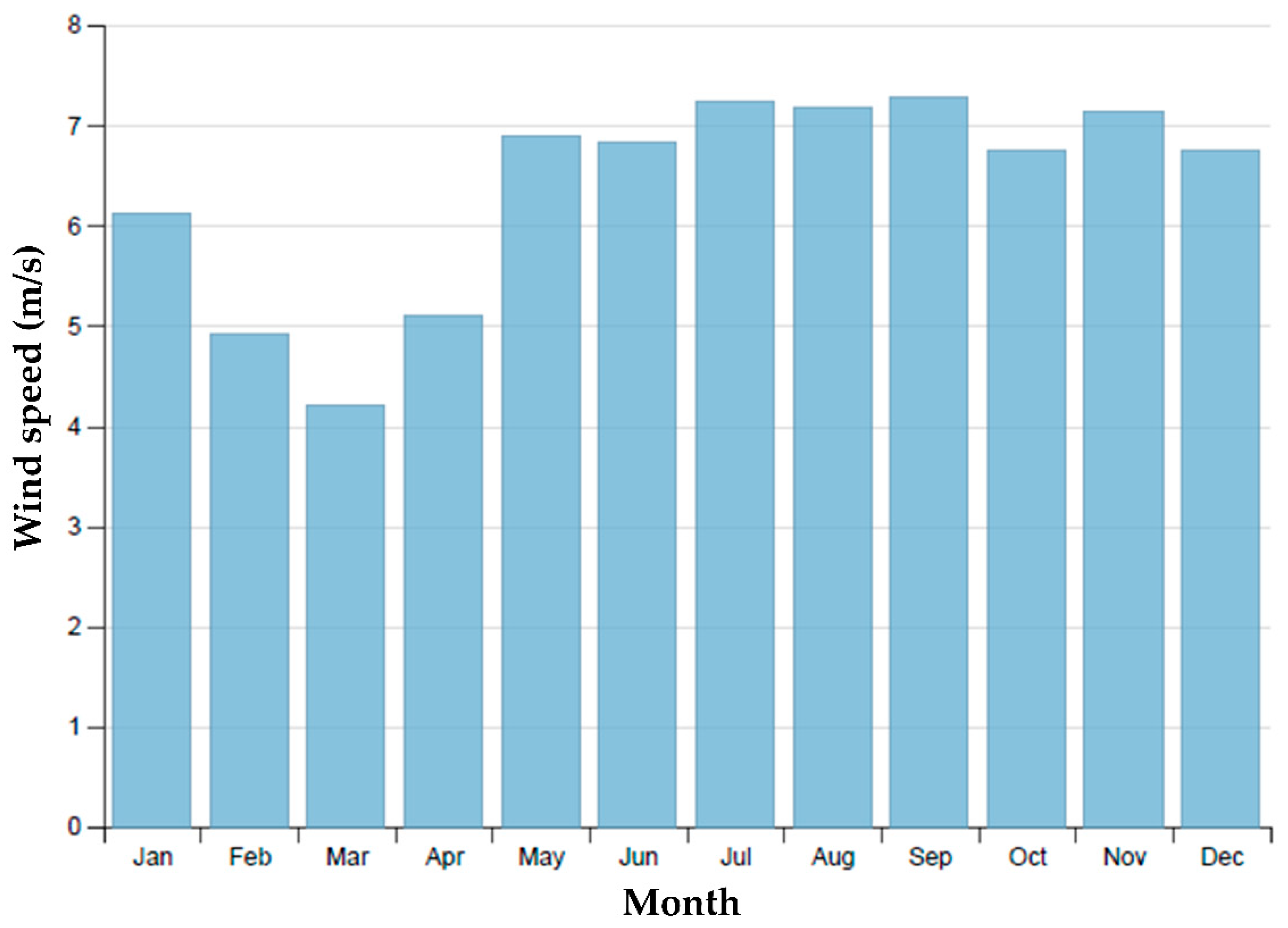
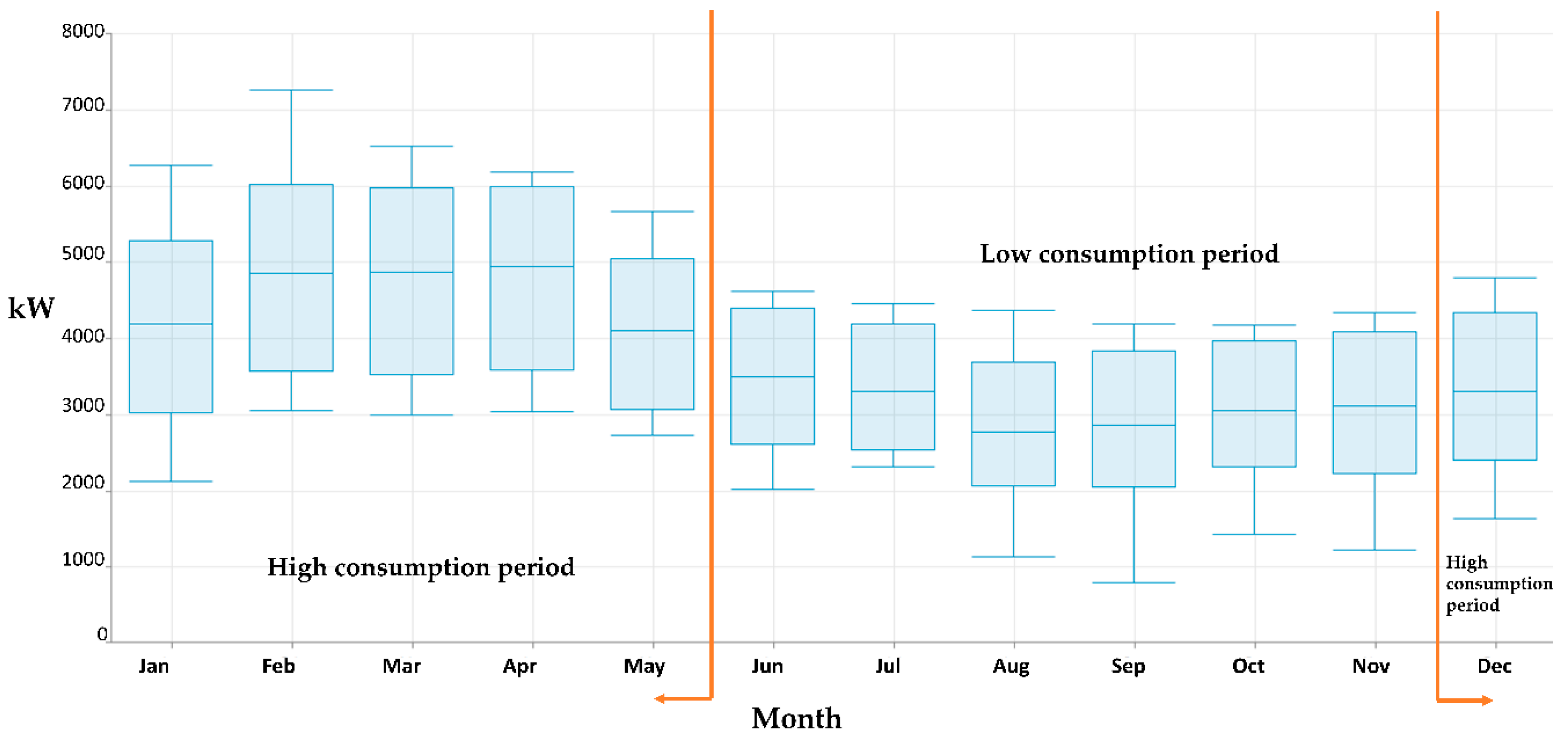
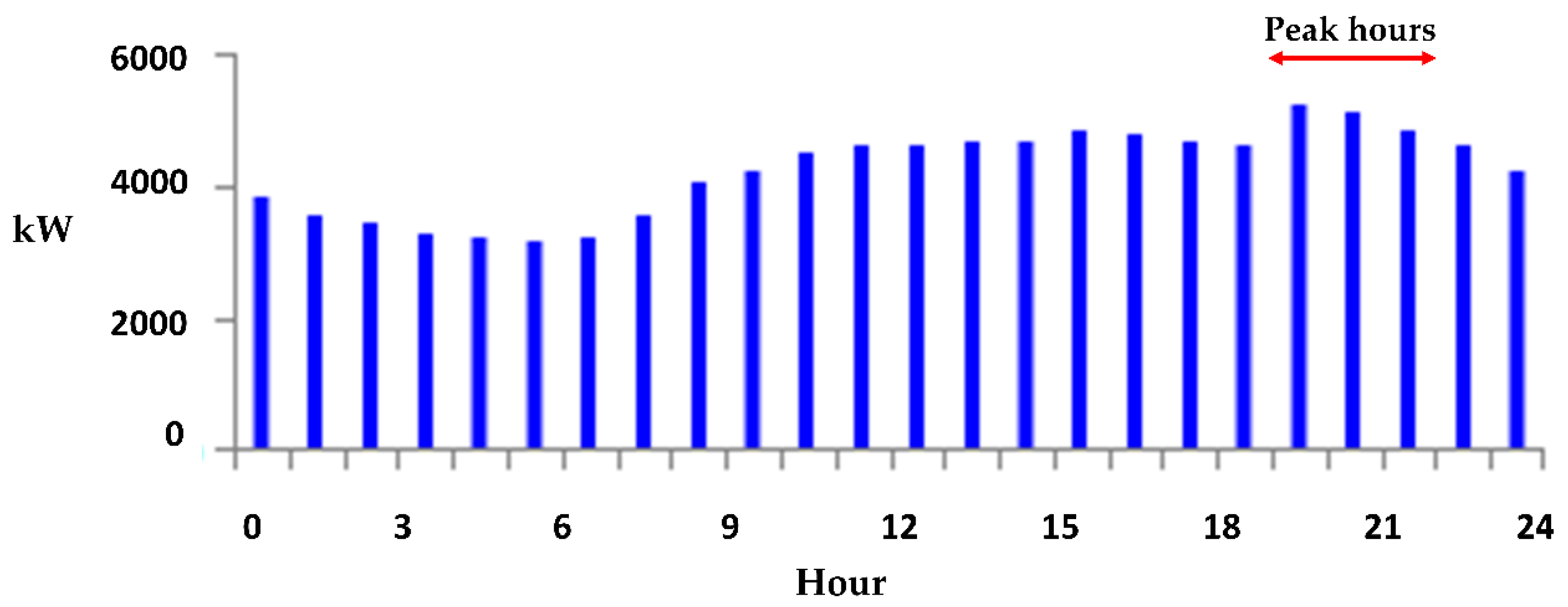
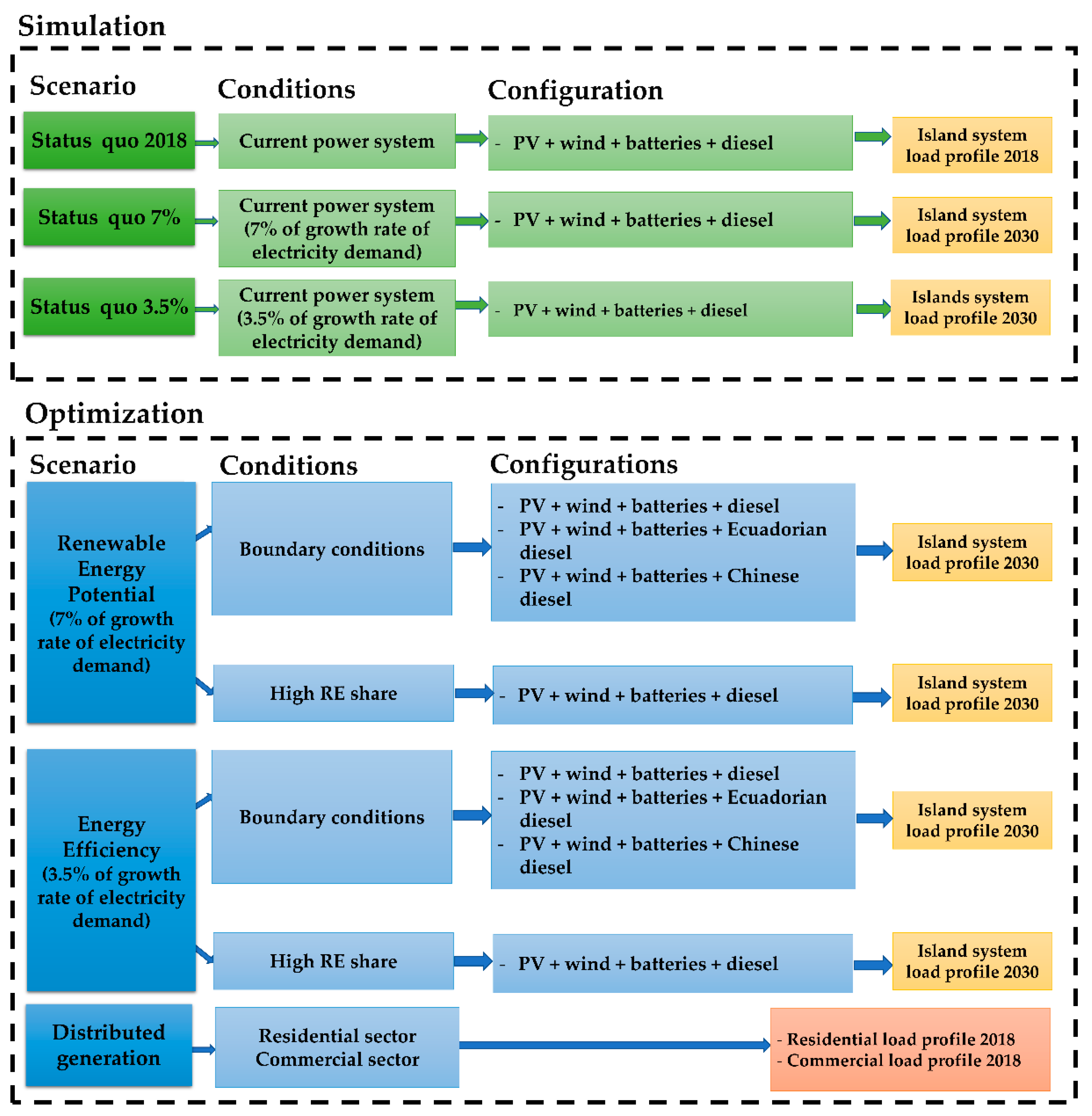
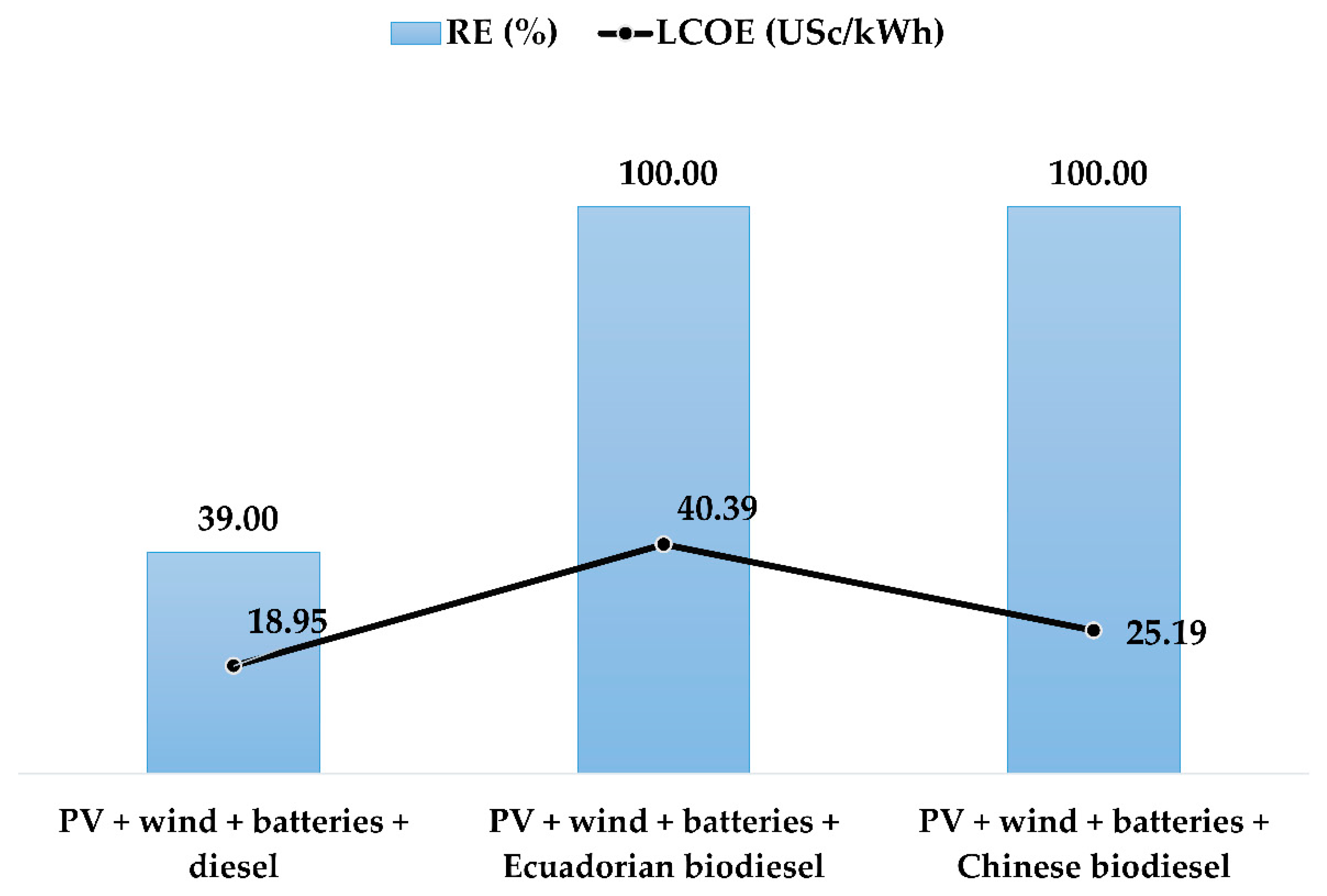

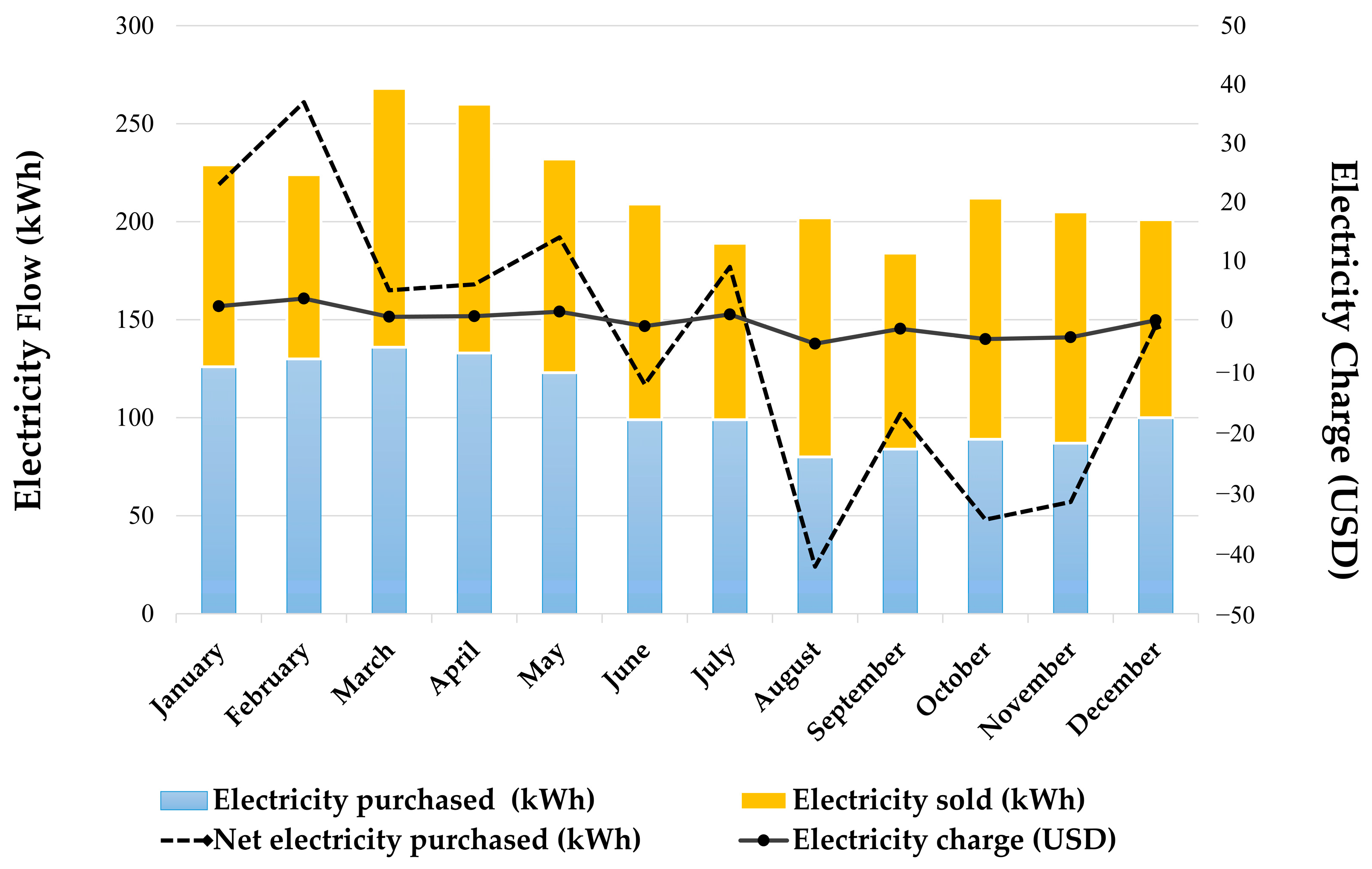
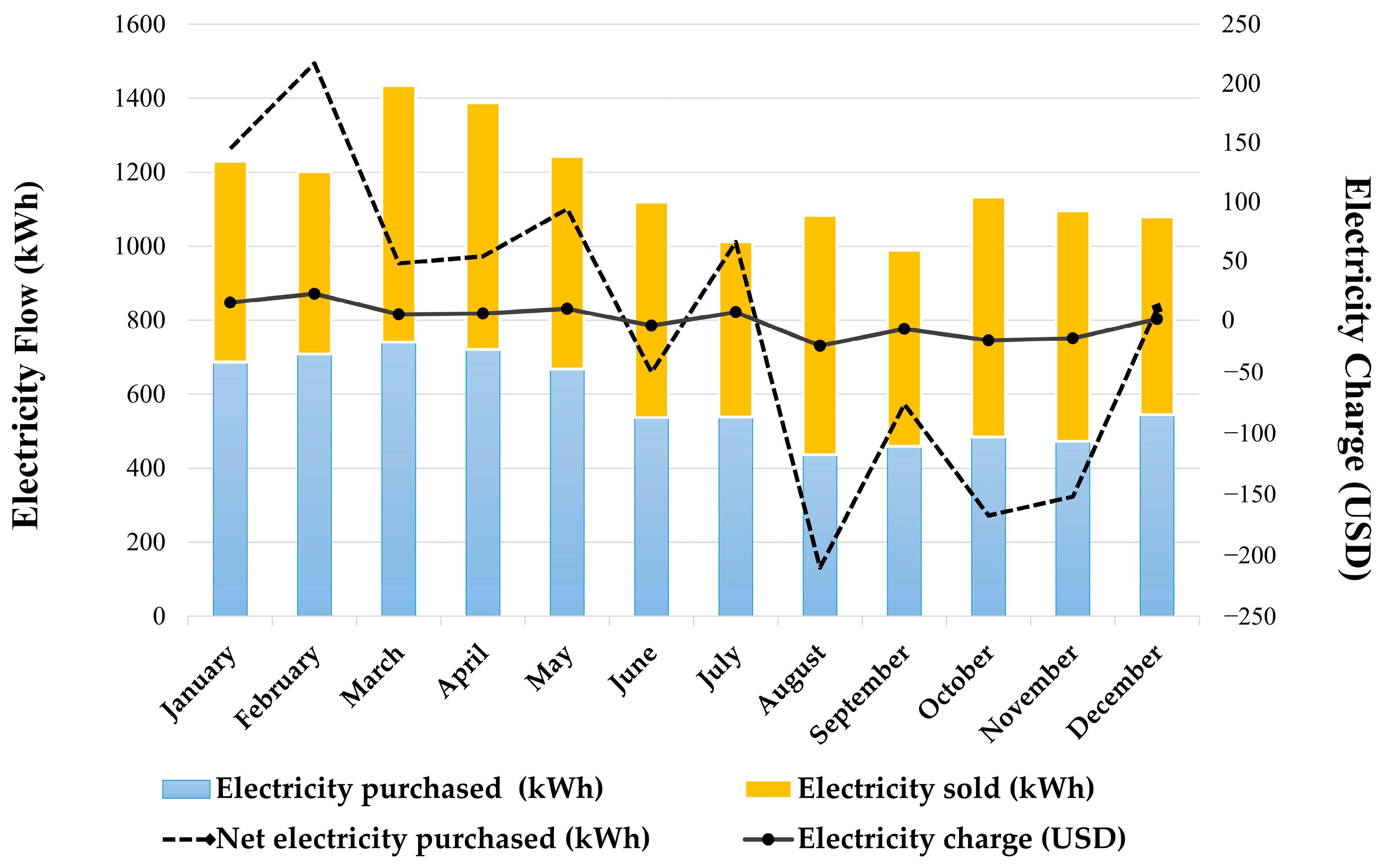

| Island | Diesel (MW) | Wind (MW) | PV (MWp) | Diesel (MW) | Biodiesel (MW) | Batteries (MWh) | Total (MW) |
|---|---|---|---|---|---|---|---|
| San Cristobal | 8.99 | 2.4 | 11.39 | ||||
| Santa Cruz-Baltra | 13.9 | 2.25 | 1.57 | 4.3 | 17.72 | ||
| Isabela | 2.63 | 0.95 | 0.33 | 3.58 | |||
| Floreana | 0.21 | 0.15 | 0.15 | 0.38 | 0.51 |
| Resource | Average | Min | Max |
|---|---|---|---|
| Daily irradiation (kWh/m2/day) | 5.70 | 4.40 | 7.40 |
| Wind speed (m/s) | 6.36 | 4.20 | 7.28 |
| Component | Parameter | Unit | Simulation | Optimization |
|---|---|---|---|---|
| Diesel | Capital | USD/kW | 340 | 0 |
| Replacement | USD/kW | 340 | 340 | |
| O&M | USD/kW/hour | 2.5–6.55 | 2.5–6.55 | |
| PV | Capital | USD/kWp | 10,600 1 | 1210 |
| Replacement | USD/kWp | 484 | 484 | |
| O&M | USD/kWp/year | 15 | 15 | |
| Wind | Capital | USD/kW | 4485 | 1500 |
| Replacement | USD/kW | 1200 | 1200 | |
| O&M | USD/kW/year | 19 | 19 | |
| Battery | Capital | USD/kWh | 856 | 300 |
| Replacement | USD/kWh | 240 | 240 | |
| O&M | USD/kWh/year | 3.75 | 3.75 | |
| Fuel | Diesel | USD/liter | 0.8 | 0.8 |
| Ecuador-biodiesel | USD/liter | - | 2.31 | |
| China-biodiesel | USD/liter | - | 1.22 | |
| Others | Interconnection Baltra–Santa Cruz | USD/kW | - | 1014 |
| Distributed generation | Capital | USD/kW | - | 1432 |
| Replacement | USD/kW | - | 215 | |
| O&M | USD/kW/year | - | 18 |
| Factors | Technical | Socio-Economic | Environmental | Political | Optimization Conditions/Constraints |
|---|---|---|---|---|---|
| Interconnection of Baltra–Santa Cruz | 7.83 MW is the remaining capacity of the Baltra substation to install additional RE power | Exceeding 7.83 MW involves an extra investment cost of $1014 USD/kW to the RE costs shown in Table 3 to install additional RE capacity | According to ELECGAPAGOS, there is not specified the area available to install new RE power | Install a maximum power of 7.83 MW of PV or wind capacity in Baltra to avoid additional costs ($1014 USD/kW) in RE investment | |
| RE technologies | Solar and wind resources are seasonally complementary | Galapagos Islands Zero Fossil Fuel Initiative aims to increase RE capacity | PV and wind technologies along with battery systems are evaluated to optimize the hybrid system Baltra–Santa Cruz | ||
| RE projects for the Galapagos Islands lack funding | The General Regulation of the LOSPEE (2019) promotes private participation to fund RE projects | Table 3 shows optimization costs under market conditions. Keeping possible investment within those values could foster a free competition in the private sector | |||
| The PME 2016–2025 contains the proposal of RE projects | |||||
| According to ELECGALAPAGOS, 14 MWp of PV can be installed in 20 ha in Santa Cruz (based on the experience of previous projects) | In Santa Cruz, there is available 20 ha for new RE projects | The National Park of the Galapagos Islands institution makes decisions about available areas to install RE projects | Install a maximum power of 14 MWp in Santa Cruz | ||
| Gensets | Gensets are the main generation systems | Diesel is highly subsidized, limiting the competition of RE | Reduction in CO2 emissions | According to the Zero Fossil Fuel Initiative, gensets capacity cannot increase | Gensets capacity cannot increase |
| The National Government is considering replacing diesel with local or Chinese biodiesel in Santa Cruz | Optimize the hybrid system with diesel and biodiesel (Ecuadorian and imported from China) | ||||
| Stability | Operating reserve is 15% | Standard 006/00 | Operating reserve is 15% for both diesel power plants and batteries | ||
| Demand | The optimized hybrid renewable power system has to be able to cover the demand in 2030 | The annual growth rate of electricity demand is 7%, high value compared to rates from developed islands | The targets of the SDG7 must be achieved in 2030 | Optimize the hybrid system to cover a demand of 73.7 GWh and 16.35 MW (peak load) in 2030 |
| Scenario | Island | Current Capacity | Techno-Economic Results | ||||||||
|---|---|---|---|---|---|---|---|---|---|---|---|
| PV | Wind | Diesel | Batteries | Unmet Load | Fuel Consumption | RE | Fuel Cost | O&M | LCOE | ||
| (MWp) | (MW) | (MW) | (MWh) | (kWh/ year) | (million liters/year) | (%) | (MUSD/ year) | (MUS/year) | (USc/ kWh) | ||
| Status quo 2018 | Baltra | 1.50 | 2.25 | - | 4.30 | - | 7.90 | 18 | 5.65 | 0.24 | 32.06 |
| Santa Cruz | 0.067 | - | 13.90 | - | |||||||
| Status quo 7% | Baltra | 1.50 | 2.25 | - | 4.30 | 527.36 | 17.71 | 8.1 | 14.166 | 0.444 | 26.73 |
| Santa Cruz | 0.067 | - | 13.90 | - | |||||||
| Status quo 3.5% | Baltra | 1.50 | 2.25 | - | 4.30 | - | 11.35 | 12 | 9.08 | 0.317 | 28.63 |
| Santa Cruz | 0.067 | - | 13.90 | - | |||||||
| Configuration | Final Configuration and Technical Results | Economic Results | |||||||||
|---|---|---|---|---|---|---|---|---|---|---|---|
| PV | Wind | Diesel | Batteries | Diesel | Biodiesel | RE | Capital | Fuel Cost | O&M | LCOE | |
| (MWp) | (MW) | (MW) | (MWh) | (million liters/year) | (%) | (MUSD) | (MUSD/year) | (MUSD/year) | (USc/ kWh) | ||
| PV + wind + batteries + diesel | 19.82 | 2.25 | 13.9 | 24.98 | 11.60 | - | 39.00 | 29.58 | 9.28 | 0.70 | 18.95 |
| PV + wind + batteries + Ecuadorian biodiesel | 20.20 | 5.45 | 13.9 | 26.26 | - | 10.50 | 100.00 | 35.22 | 24.15 | 0.76 | 40.39 |
| PV + wind + batteries + Chinese biodiesel | 20.03 | 5.45 | 13.9 | 25.62 | - | 10.77 | 100.00 | 34.82 | 13.15 | 0.75 | 25.19 |
| Technical Results | Economic Results | ||||||||
|---|---|---|---|---|---|---|---|---|---|
| PV | Wind | Diesel | Batteries | Fuel Consumption | RE | Capital | Fuel Cost | O&M | LCOE |
| (MWp) | (MW) | (MW) | (MWh) | (million liters/year) | (%) | MUSD/year | (MUSD/year) | (MUSD/year) | (USc/kWh) |
| 79.14 | 74.25 | 13.9 | 359.27 | 5.66 | 70 | 461.29 | 4.53 | 6.23 | 98.34 |
| Configuration | Final Configuration and Technical Results | Economic Results | |||||||||
|---|---|---|---|---|---|---|---|---|---|---|---|
| PV | Wind | Diesel | Batteries | Diesel | Biodiesel | RE | Capital | Fuel Cost | O&M | LCOE | |
| (MWp) | (MW) | (MW) | (MWh) | (million liters/year) | (%) | (MUSD) | (MUSD/ year) | (MUSD/ year) | (USc/ kWh) | ||
| PV + wind + batteries + diesel | 10.97 | 2.25 | 13.9 | 4.3 | 7.99 | - | 37.50 | 12.53 | 6.39 | 0.41 | 17.10 |
| PV + wind + batteries + Ecuadorian biodiesel | 15.71 | 5.45 | 13.9 | 4.3 | - | 6.62 | 100.00 | 23.06 | 15.22 | 0.51 | 37.92 |
| PV + wind + batteries + Chinese biodiesel | 12.25 | 5.45 | 13.9 | 4.3 | - | 6.99 | 100.00 | 18.87 | 8.53 | 0.47 | 23.22 |
| Technical Results | Economic Results | ||||||||
|---|---|---|---|---|---|---|---|---|---|
| PV | Wind | Diesel | Batteries | Fuel Consumption | RE | Capital | Fuel Cost | O&M | LCOE |
| (MWp) | (MW) | (MW) | (MWh) | (million liters/year) | (%) | (MUSD/year) | (MUSD/year) | (MUSD/year) | (USc/kWh) |
| 58.35 | 47.85 | 13.9 | 90.30 | 3.79 | 70 | 268.00 | 3.03 | 3.64 | 85.03 |
| User | Technical Results | Economic Results | |||||
|---|---|---|---|---|---|---|---|
| PV | Electricity Purchased | Electricity Sold | RE | Capital | O&M | LCOE | |
| (kWp) | (kWh/year) | (MW) | (%) | (USD) | (USD/year) | (USc/kWh) | |
| Residential | 1.50 | 1289 | 1328 | 64.70 | 2148 | 23.13 | 8.37 |
| Commercial | 8.00 | 7000 | 7005 | 64.20 | 11,456 | 143.47 | 8.42 |
| Sensitivity Variables | Current Capacity | Techno-Economic Results | ||||||||
|---|---|---|---|---|---|---|---|---|---|---|
| PV | Wind | Diesel | Batteries | Fuel consumption | RE | Fuel cost | O&M | LCOE | ||
| (MWp) | (MW) | (MW) | (MWh) | (million liters/year) | (%) | (MUSD/year) | (MUSD/ year) | (USc/ kWh) | ||
| Fuel price | Base scenario | 1.57 | 2.25 | 13.9 | 4.3 | 7.90 | 18 | 5.65 | 0.24 | 32.06 |
| $1 US/liter | 1.57 | 2.25 | 13.9 | 4.3 | 7.90 | 18 | 7.06 | 0.25 | 36.37 | |
| Sensitivity Variables (costs) | Final Configuration and Technical Results | Economic Results | |||||||||
|---|---|---|---|---|---|---|---|---|---|---|---|
| PV | Wind | Diesel | Batteries | Fuel Consumption | RE | Capital | Fuel Cost | O&M | LCOE | ||
| (MWp) | (MW) | (MW) | (MWh) | (million liters/year) | (%) | (MUSD) | (MUSD/ year) | (MUSD/ year) | (USc/ kWh) | ||
| Base scenario | 19.82 | 2.25 | 13.90 | 24.98 | 11.60 | 39.00 | 29.58 | 9.28 | 0.70 | 18.95 | |
| PV | −20% | 19.95 | 2.25 | 13.90 | 33.30 | 11.58 | 39.10 | 27.79 | 9.26 | 0.75 | 18.71 |
| Wind | −20% | 11.68 | 5.45 | 13.90 | 27.54 | 12.50 | 34.30 | 24.34 | 10.00 | 0.66 | 18.98 |
| Batteries | −20% | 16.58 | 5.45 | 13.90 | 24.34 | 11.30 | 40.60 | 28.80 | 9.04 | 0.71 | 18.49 |
| Fuel | $1 US/ liter | 19.95 | 2.25 | 13.90 | 33.30 | 11.57 | 39.10 | 32.24 | 11.57 | 0.75 | 22.64 |
| Sensitivity Variables (costs) | Final Configuration and Technical Results | Economic Results | |||||||||
|---|---|---|---|---|---|---|---|---|---|---|---|
| PV | Wind | Diesel | Batteries | Fuel Consumption | RE | Capital | Fuel Cost | O&M | LCOE | ||
| (MWp) | (MW) | (MW) | (MWh) | (million liters/year) | (%) | (MUSD) | (MUSD/year) | (MUSD/year) | (USc/ kWh) | ||
| Base scenario | 10.97 | 2.25 | 13.9 | 4.30 | 7.99 | 37.50 | 12.53 | 6.39 | 0.41 | 17.10 | |
| PV | −20% | 11.89 | 2.25 | 13.9 | 4.30 | 7.81 | 38.90 | 11.15 | 6.25 | 0.42 | 16.46 |
| Wind | −20% | 10.00 | 5.45 | 13.9 | 4.30 | 7.39 | 42.20 | 15.19 | 5.91 | 0.44 | 16.90 |
| Batteries | −20% | 11.07 | 2.25 | 13.9 | 4.30 | 7.97 | 37.70 | 12.42 | 6.37 | 0.41 | 17.04 |
| Fuel | $1 US/liter | 11.34 | 5.45 | 13.9 | 4.30 | 7.13 | 44.20 | 17.78 | 7.13 | 0.46 | 20.08 |
| User | Sensitivity Variables | Technical Results | Economic Results | ||||||
|---|---|---|---|---|---|---|---|---|---|
| PV | Electricity Purchased | Electricity Sold | RE | Capital | O&M | LCOE | |||
| (kWp) | (kWh/year) | (MW) | (%) | (USD) | (USD/year) | (USc/kWh) | |||
| Residential | PV cost | −20% | 1.50 | 1289 | 1328 | 64.70 | 1718 | 17.73 | 6.67 |
| Base scenario | 1.50 | 1289 | 1328 | 64.70 | 2148 | 23.13 | 8.37 | ||
| +20% | 1.50 | 1289 | 1328 | 64.70 | 2578 | 28.53 | 10.10 | ||
| Commercial | PV cost | −20% | 8.00 | 7000 | 7005 | 64.20 | 9165 | 114.67 | 6.73 |
| Base scenario | 8.00 | 7000 | 7005 | 64.20 | 11,456 | 143.47 | 8.42 | ||
| +20% | 8.00 | 7000 | 7005 | 64.20 | 13,747 | 172.27 | 10.10 | ||
© 2020 by the authors. Licensee MDPI, Basel, Switzerland. This article is an open access article distributed under the terms and conditions of the Creative Commons Attribution (CC BY) license (http://creativecommons.org/licenses/by/4.0/).
Share and Cite
Eras-Almeida, A.A.; Egido-Aguilera, M.A.; Blechinger, P.; Berendes, S.; Caamaño, E.; García-Alcalde, E. Decarbonizing the Galapagos Islands: Techno-Economic Perspectives for the Hybrid Renewable Mini-Grid Baltra–Santa Cruz. Sustainability 2020, 12, 2282. https://doi.org/10.3390/su12062282
Eras-Almeida AA, Egido-Aguilera MA, Blechinger P, Berendes S, Caamaño E, García-Alcalde E. Decarbonizing the Galapagos Islands: Techno-Economic Perspectives for the Hybrid Renewable Mini-Grid Baltra–Santa Cruz. Sustainability. 2020; 12(6):2282. https://doi.org/10.3390/su12062282
Chicago/Turabian StyleEras-Almeida, Andrea A., Miguel A. Egido-Aguilera, Philipp Blechinger, Sarah Berendes, Estefanía Caamaño, and Enrique García-Alcalde. 2020. "Decarbonizing the Galapagos Islands: Techno-Economic Perspectives for the Hybrid Renewable Mini-Grid Baltra–Santa Cruz" Sustainability 12, no. 6: 2282. https://doi.org/10.3390/su12062282
APA StyleEras-Almeida, A. A., Egido-Aguilera, M. A., Blechinger, P., Berendes, S., Caamaño, E., & García-Alcalde, E. (2020). Decarbonizing the Galapagos Islands: Techno-Economic Perspectives for the Hybrid Renewable Mini-Grid Baltra–Santa Cruz. Sustainability, 12(6), 2282. https://doi.org/10.3390/su12062282





